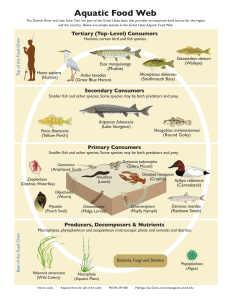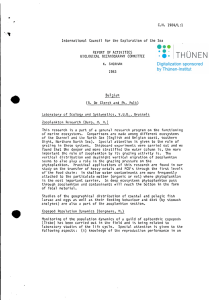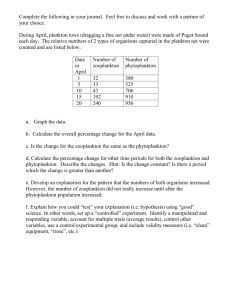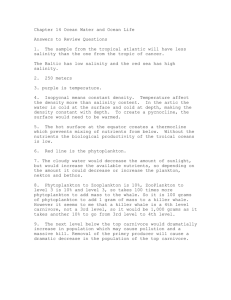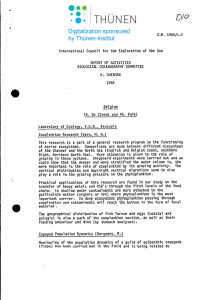the ptivsical and biological processes that interact
advertisement
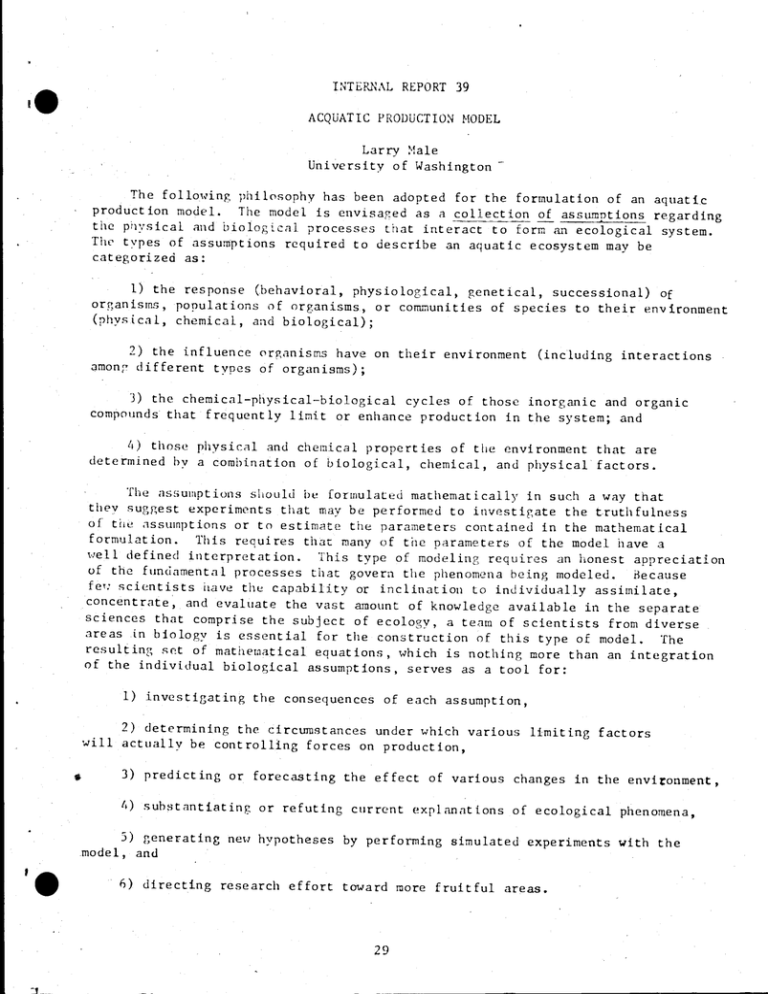
INTERNAL REPORT 39
ACQUATIC PRODUCTION MODEL
Larry Male
University of Washington
The following philosophy has been adopted for the formulation of an aquatic
The model is envisaged as a collection of assumptions regarding
the ptivsical and biological processes that interact to form an ecological system.
production model.
The types of assumptions required to describe an aquatic ecosystem may be
categorized as:
1) the response (behavioral, physiological, genetical, successional) of
organisms, populations of organisms, or communities of species to their environment
(physical, chemical, and biological);
2) the influence organisms have on their environment (including interactions
among different types of organisms);
3) the chemical-physical-biol..ogical cycles of those inorganic and organic
compounds that frequently limit or enhance production in the system; and
4) those physical and chemical properties of the environment that are
determined by a combination of biological, chemical, and physical factors.
The assumptions should be formulated mathematically in such a way that
they suggest experiments that may be performed to investigate the truthfulness
of the assumptions or to estimate the parameters contained in the mathematical
formulation. This requires that many of the parameters of the model have a
well defined interpretation. This type of modeling requires an honest appreciation
of the fundamental processes that govern the phenomena being modeled. Because
feT: scientists have the capability or inclination to individually assimilate,
concentrate, and evaluate the vast amount of knowledge available in the separate
sciences that comprise the subject of ecology, a team of scientists from diverse
areas in biology is essential for the construction of this type of model. The
resulting set of mathematical equations, which is nothing more than an integration
of the individual biological assumptions, serves as a tool for:
1) investigating the consequences of each assumption,
2) determining the circumstances under which various limiting factors
will actually be controlling forces on production,
3) predicting or forecasting the effect of various changes in the environment,
4) substantiating or refuting current explanations of ecological phenomena,
5) generating new hypotheses by performing simulated experiments with the
.model, and
6) directing research effort toward more fruitful areas.
29
The following set of assumptions comprise the current state of a preliminary
model of the production dynamics in a generalized coniferous forest lake.
It is based upon literature review and frequent discussions with scientists
participating in the IBP program.
The model is general in the sense that it
will represent the dynamics of a particular lake only when parameters unique
to that lake are incorporated.
Four sources of estimates for the parameters
in the model are recognized:
1) studies conducted on proposed lakes before the initiation of IBP;
2) investigations proceeding under IBP support (some of these projects
are designed to provide estimates of parameters that are unique to particular
lakes and others are designed to improve the predictive capabilities of the
model by testing the assumptions upon which the model is based);
3) survey of literature on limnology, oceanography, ecology of aquatic
environments, physiology and behavior of aquatic organisms, natural selection,
and succession; and
4) estimates of parameters derived from the model by fitting the model
to observed fluctuations in production.
PHYTOPLANKTON SUBIIODEL
The production dynamics of a community of phytoplankton is hypothesized
to follow a model similar in general form to the one formulated by Y'ile"" et
al. (1949),
ap
at = (Ph-R-D) p - G r
where
+
-1--p ;'oz
oz
)
p(t,z) is the concentration of phytoplankton at deptib z at time t
{mg(carbon)m 3),
Ph is photosynthetic rate for unit plant concentration {mg(carbon
assimil.ated)day
1
per mg`carbon in phytoplankton},
R is respiration rate of unit concentration of plants frog (carbon
respired)day-3 per mg carbon in phytoplankton},
D is rate of loss because of decomposition for unit concentration
of plants {mg(carbon decomposed)day1 per mg carbon in phytoplankton},
G
is the rate of loss attributed to grazing by herbivorous zooplankton
r {mg(carbon
grazed)day 'm 3},
is the coefficient of eddy diffusivity for the community of
phytoplankton {mg(carbon)sec 1m 1},
p is density of water {g(H2o)/cm3(H20)},
s is sinking rate of phytoplankton at 0°C {m-day-1),
u
is the dynamic viscosity of water at 0°C,
A
is the dynamic viscosity of water at. T°C,
(A
_J_
3z
p az
is the rate of change in concentration of phytoplankton at any
depth attributed to mixing by eddy currents, and
is suo 3
uT
8z
is the rate of c han ge
i
n concen t ra ti on o f
phytoplankton at any
depth attributed to sinking of algal cells.
30
hull of the
The above partial differential equation represents only the
chemical,, and biological
model; many of the coefficients are functions of physical,
forces that comprise the phytoplankton's environment.
Photosynthetic rate
Notation ,
time t
ni(t,z) is the concentration of nutrient i at depth z at
{
gm 3},
i = 'C is CO,
Po is phosphate
N is nitrate
S is silica,
1(z) is the light intensity at depth z,
(t) is the surface light intensity at time t,
T(g z) is the temperature at depth z at time t,
( grow th rate at
K -T is the saturated growth rate at temperature T
nutrient
concentrations),
optimal light intensity and
greater
F(I) is reduction in growth rate attributed to light intensities
and
h an an d less than optimal intensity,
rate
attributed
to less than optimal
il(nC,npo,nN,nS) is reduction in growth
concentrations of nutr i en t s.
I
t
general form
The photosynthetic rate is assumed to follow the
P
h
= K.T.F .H,
where the various functions are defined as
1(z) = Ioexp{-kPz
-
Jzf(PC(t,x))dx},
f(y) = 0.0080y + 0.054y213,
l:
e
Riley (1956),
is the extinction coefficient of water excluding the phytoplankton,
Jz f(PC(t,x))dx is the extinction of light at
depth z because of self-
shading by phytoplankton,
m3
Pi, is the concentration of chlorophyll a in mg
(P - a p where a is the chlorophyll-to-carbon ratio of phytoplankton)
c
c
C
F(l) Q
I
I9
exp{l - II Steele (1965), and
is the light intensity for optimum growth rate.
Several models for 11 have been proposed.
Let mi (X)
X+h
(i = C, Po, N, S) , where K, is the Michaelis-Mentor half
saturation constant, then If may be modeled as
11 =
i mi (ni)
or
I1
min mi (n i )
i
31
The assumption may now be stated as
/.
t
z
t
lie dynamics of production at any depth is represented by
(A--i.-D)
t;her!r
:'t
(-(t
)
is the assimilation rate for unit zooplankton concentration {ug(carbon
assimilate !) claw
per rf; carbon in zooplankton,
is the respiration rate of unit concentration of zooplankton
{ng(carbon respired)day
'
per r.,o carbon in zooplankton}, and
i is rate of loss because_ of death for unit concentration of zooplankton
trng(carbon c::p.ired)day per n;.; carbon in zooplankton}.
r
Fish nredatio. upon zooplankton is assumed to depend upon the total
ornount of zooplankton in the water column, according to a Hollinl; disc
equation, i.e.,
P.
DF
=
7.k
(i: +Z* ) r,
1
i71 ere
RF
F
is the saturated predation rate, and
is the density of fish in the water column.
The production dynamics of zooplankton may now be expressed as
dZ
dt
=
4-
[f
DF.
Assimilation rate.
In the pI vtoplanicton model, we defined the p,ra'in;g rate of zooplankton
per unit of zoopl.anl:ton to he
R Ti'
gr
t
K -4-p
The assimilation efficiency, az, of zooplankton is hypothesized to depend upon
the grazing rate according to
a
z
fir
K a+g r
K
=
a
K 3+g r
33
The assimilation rate per unit zooplankton is then
A.- a Rr
Kagr
Ka+gr
Respiration Rate
A I.inea,r dependence upon temperature is supported by data in the literature
R = KT
2
{day 1('C)
KZ m 0.' ± 0.1
1}
LIMNETIC ORGANIC POOL--SUBSTRATE FOR DECOMPOSITION
organic pool is the collection of dead organic matter,
suspended in the water column, that provides a substrate for bacterial
decomposition. The rate of. change in the concentration of organic matter
The limnetic
{mg m 3day
1}
at any depth is expressed as
0
t
where
= D P + D A + A - BOP +
p
Z
P
a ()
(A -0 ) - S 0PDz
P
z OPz
P
0I,(t,z) is the concentration of organic carbon at depth z at time t
death rate of phytoplani, ton mm 'day
DPp
DzZ
i:; death rate of zooplankton
mgn.
f
idnv-1)
'}
{ngm
3},
,
,
{mgm_3day'
A is rate of addition of organic carbon from allochthonous sources
R is rate of decomposition for unit concentration of organic matter,
is coefficient of eddy diffusivity for organic pool,
A0
1'
a
T(A0
-L,-0P) represents the rate of mi::inp of organic matter vertically
in the water column,
P
and
S1 is sinking rate of suspended particles {ndav
P
OPazP
is loss from water column attributed to sin':inp
rigti
'day '
Sacteri al !)ccomposition
B is as yet undetermined function of temperature, p:i, and other chemical
reactions.
ITr:O''i:',
Pi!OSP??O??(ll'S (T"CLP S17MOD!;T,
",l though the riitro;'en and T11 osr1ornti; c:cles are quitc -.:i ffnrent,
the
following; general formulation c`iaracterizf-s those feature; that seem to be
common to both cycles. The following sources and sinks of nutrient have been
recognized.
34
EZ is rate of nutrient excretion by zooplankton {mLm 3day 1},
is rate of nutrient liberation from organic pool by decomposition,
is rate of nutrient addition from inflow streams, ground water, and
drainage of fertilized farm land,
ES is rate of gain or loss attributed to equilibrium exchange with
J
bottom sediments,
Eh
is rate of gain or loss attributed to equilibrium exchange with
suspended particles,
S
is sedimentation rate of nutrient absorbed on suspended particles
e
{i,Iday }, and
RP is rate of removal of nutrient by phytoplankton.
r
i
The rate of change in nutrient concentration at any depth is represented
as the sum
at
E7+J+RI+ES+
- P' - aS0 3z 0
L.
P
P
+
x
z
(A
v
3z P )
+
dz
z-n)
n
Ij
where a is nutrient-to-carbon ratio of organic pool.
Zooplankton excretion is taken to be the difference between the grazing
rate and the assimilation rate of zooplankton. The nutrient liberation is taken
to be proportional to the carbon content of the excretory products. The
proportionality constant is the nutrient-to-carbon ratio of the excretory
products (ape).
E,,
The model may be expressed as
aPCr a
PC
G
z
K Z+C:
a
r
azGr]
using; substitutions from phytoplankton and zooplankton
soboodels,
cihe re
Cr is the grazing rate {mgm 3day 1}, and
aZ is the assimilation efficiency of zooplankton
t'.elease rate of nutrient attributed to bacterial decomposition is taken
to be J = a15.0
P
Eo ilibrium exchange with sediments and s pended particles has no model
as yet proposed. The following factors are recognized as important:
1) cycles of iron and manganese,
2) oxidation-reduction potentials,
3) pH,
4) oxygen concentrations,
5) ratio of lake surface area to area of bottom sediments exposed to
epilemnion,.
6) temperature gradients, and
7) nitrogen -fixing algae and bacteria.
35
ytorl.anikton of nutrient is taken to be °.P = an - Ph
W -is the nutrient-to-carbon ratio of phytoplankton,
1'n is the photosynthetic rate of phytoplankton,
aSt) 2 O is the rate of sedimentation of nutrient absorbed upon suspended
p
particles,
p
(AO
is the rate of mixing of nutrient absorbed upon suspended
Uptake by
where
a
P
a
a
a
a
)
P
az(Anai )
particles, and
is the rate of mixing
of soluble
nutrient.
SOCKEYE SAT-? ON SUBMODEL
The rate of change in fish carbon per unit volume is assumed to follow
the model
dF
dt
= (G - D)F - F P
where
f(t) is concentration of fish carbon {mgm-3} at time t,
G is growth rate per unit concentration of fish,
is death rate per unit concentration of fish, and
F1,is rate of predation by squawfish, etc.
1)
Growth rate will depend upon temperature, amount of food ingested, and
body size of the fish. An analytic statement of the results obtained by
Brett (1969) for, the relation between growth rate of sockeye and temperatureration combinations is forthcoming. Figure 1.
The salient feature of the results is that the temperature for optimum
growth depends upon the level of ration. Because sockeye salmon exhibit
marked vertical migrations (through a substantial temperature gradient) a strategy
model for optimum growth is being considered.
Death rate is proposed to depend upon the well-being of the fish as
measured by condition factors, or specific growth rate.
to the
A model similar
one used for phytoplankton is being considered.
Predation rate is assumed
FP
KFijF
+F
to follow
a Rolling disc equation
)Pr,
where
u is the saturated predation rate, and
is the concentration of salmon predators (squawfish).
P
r
36
1.5
relative
growth
rate
Relation between growth rate of sockeye salmon
Figure 1.
and temperature-ration combinations.
37
RE FERENICES
BELLA, D. A.
1970.
Simulating the effect of sinking and vertical mixing on
algal population dynamics.
J. WPCF, 5:(5) part 2:140-152.
BRETT, J. R., J. E. SHELBOURN, and C. F. SHOOP.
1969.
Growth rate and.body
composition of fingerling sockeye salmon, Oncorhvnchus nerka, in relation to
temperature and ration size. J. Fish. Res. Board Can. 26:2363-2394.
D. J. O'CO;INOR, and R. V. TIIOMANN. 1')70. A dynamic model of
phytoplankton populations in natural waters. Manhattan College, Bronx, N.Y., June.
DiTORO, D. M.
,
1957, 1967.
HUTCIIINSON, G. E.
A treatise on limnology.
John Wiley & Sons, Inc.,, New York.
Vol. I and II.
p-
1,,e BRASSEUR, R. J., W. E. BARRACLOUGH, 0. D. KENNEDY, and 1'. R. PARSONS.
1969.
Production studies in the Strait of Georgia. Part III.
Observations
on the food of larval and juvenile fish in the Fraser River plume, February
to :lay, 1967.
J. Exp. :-tar. Biol. Ecol. Vol. 3:51-61.
1971.
LO;N'.BAP.I10, P. S.
A mathematical :aodel of water quality in an impoundment.
M.S. thesis, Univ. of tIashington, Seattle.
__cALLISTER, C. D.
1969.
phytoplankton production.
121 p.
Aspects of estimating zooplaul:ton production from
J. Fish. Res. Board Can. 26:199-220.
PARSONS, T. R., l. ST[PHi:':S, and ,.. J. LeBRASSEUR.
1969.
Production Studies
In the Strait of Georgia. Part 1. Primary Production un (,r the Fraser iLiver
Plume, February to INay, 17 . J. Lxp. `;ar. Biol. r:col, Vol 3:27-38.
PARSONS, T. .;. ,
R. J. LC'BP,SSEUR, J. P. FUL ON, and 0.
D.
1969.
Production studies in the Strait of Georgia.
Part 11.
Secondary production
under the Fraser River Plume, February to Nay, 1967. J. Exp. 'tar. Biol. ..col.
Vol. 3:39--50.
PILEY, G. A.
Bank.
1946.
Factors controlling phytoplankton populations on Georges
J. Mar. Res. VI(1) :54-73.
RILEY, G. A. 1947. A theoretical analysis of
of Georges Bank. J. Mar. Res. VI(2):104-113.
I'.ILEY, G. A.
in New
1947.
the zooplankton population
Seasonal fluctuations of the phytoplankton population
England coastal waters.
J. I'ar. Res. ':I (2) :114-125.
''I1.I:Y, G. A., 11. STO'NE.L, and D. F. PU"PUS.
1949.
Quantitative ecology of
the plankton of the western North Atlantic. Contribution No. 464, Woods
Hole Oceanographic Institution, XII, Art. 3.
PILEY, C. A.
1963.
'I. Bill (ed.), The
Theory of food-chain relations in the ocean.
p. 438-463.
sea.
38
In:
i
RUSSELL-HUNTER, W. D.
London.
1970.
Aquatic productivity. The Macmillan Company,
306 p.
STEELE, J. H.
1958.
The quantitative ecology of marine phytoplankton.
Biol. Rev. 34:129-158.
SVERDRUP, H. V., M. W. JOHNSON, and R. H. FLEMING.
Prentice-Hall,
Inc., New
York.
1942.
The Oceans.
1087 p.
THOMANN, R. V., D. J. O',CONNOR, and D. N. DiTORO.
nitrogen and algal cycles in estuaries.
Pollut. Res. Conf., July-August.
39
1970.
Modelling of the
Presented at the 5th Int. Water

